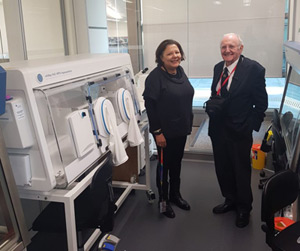- Details
-
Created: Saturday, 05 November 2016 17:51
Increased production of ROS, which is both a symptom and a driver of cancer Hallmarks, can push cancer cells over the cliff of oxygen homeostasis. Compounds adding oxidative pressure can thus be utilized for selective tumor therapy. In their paper “Triggering apoptosis in cancer cells with an analogue of cribrostatin 6 that elevates intracellular ROS” , HypOxystation users Asby et al. describe their approach to chemically modifying a natural compound from marine sponges, cribrostatin 6, to enhance its cytotoxic potential. They synthesized a modified molecule 8-phenylcribrostatin 6 (8PC6) that was both more potent and more selective for breast cancer cells. Co-author Ali Tavassoli from the University of Southampton says, "We study HIF-1, so working in a hypoxic environment is critical. Besides culturing our cells in the H35, we also harvest proteins and collect RNA inside the chamber. The H35 is very easy to use; the touch screen controls are straightforward and intuitive. We have used the workstation to incubate cells in hypoxia for ~5 days, and the atmosphere remains stable over time."
Annexin V/7-AAD staining indicated that 8PC6 induces apoptosis in cancer cells. Treatment of MCF7 cancer cells with ROS-sensing dyes and siRNA to knock down ROS-protective TIGAR demonstrated that 8PC6 increases intracellular reactive oxygen species, upsetting the delicate redox balance in highly susceptible cancer cells and leading to cell death. Hypothesizing that reduction of the cribrostatin analogue yields a semi-quinone that reacts with molecular oxygen to generate superoxide, Asby’s group decided to withdraw oxygen from the equation by incubating the MCF7 cells in the HypOxystation at 1% O2. Pre-incubation and subsequent incubation with increasing doses of 8PC6 in normoxia versus hypoxia showed that, indeed, the IC50 was increased up to 46-fold in hypoxia due to lack of oxygen. The HypOxystation’s closed workstation format and rigorous control of oxygen, CO2, temperature and humidity facilitates authentic cell behavior as in vivo conditions are replicated. Thus, hypoxia in the workstation equated to significant reduction in the intracellular availability of oxygen for the generation of ROS. For research being conducted on highly hypoxic tumors, the workstation atmosphere represents a close approximation of the actual conditions cells encounter.
Read more: Jumping Off the Redox Cliff
- Details
-
Created: Monday, 10 October 2016 19:11
We at HypOxygen hope you had a constructive World Heart Day! The World Heart Federation prompts us to find ways to create a heart-healthy environment by exercising more and eating more healthily. Work by our HypOxystation users demonstrates the benefits of creating healthy environments for cell culture, by providing more physiological, low oxygen conditions that let cells breathe. The closed culture workstation controls oxygen, CO2, temperature and humidity throughout the duration of culture and manipulation, ensuring that ambient air does not compromise the physiology and growth of the cells. Cardiovascular researchers all around the world are culturing their cells at physioxia in the HypOxystation.
In his 2016 paper on post-MI remodeling, HypOxystation user Li et al. investigated the role of miR-7a/b in cardiomyocytes responding to oxidative stress/hypoxia. Similarly to the conditions during and after MI, miR-7a/b and their target molecules PARP-1 and Sp1 protect cardiomyocytes from apoptosis and reduce fibrosis in an oxygen-dependent manner. The authors postulate that hypoxia-induced injury to the heart can be mitigated by modified miRNA expression, helping to prevent heart failure. As with Li’s work, the results obtained by another HypOxystation user, Jim Uniacke at University of Guelph, show “the importance of oxygen as a cell culture parameter when making physiological inferences.”
Read more: Creating Healthy Environments for Cell Culture
 Dr Don Whitley, chairman and founder of DWS, recently visited
Dr Don Whitley, chairman and founder of DWS, recently visited